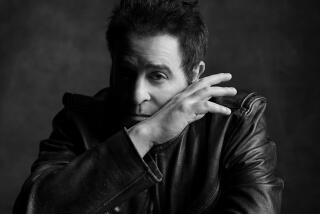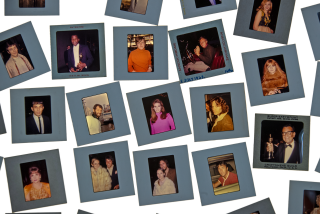Robert LaVigne dies at 85; artist painted central Beat figures
- Share via
Robert LaVigne, an artist and set designer whose subjects and collaborators included many of the central figures of the Beat movement, including Allen Ginsberg, Jack Kerouac and Robert Creeley, died Feb. 20 in Seattle. He was 85.
LaVigne had been in poor health after a number of strokes, said his friend Joe Lee.
An Idaho native, LaVigne moved to San Francisco around 1951 and became an important member of the bohemian subculture that soon flourished there. The painter among poets, he created portraits of many of its luminaries, including Philip Whalen, Kerouac and Creeley, made poet Philip Lamantia a floor-length cape to wear for a “Mad Monster Poets’ Reading,” and transformed poet Michael McClure into a wolf man for the cover of a recent reissue of McClure’s signature 1964 collection, “Ghost Tantras.” He painted Ginsberg and designed the cover of a special fine press edition of his classic “Howl” published in 1971.
LaVigne also was a model for characters in two Kerouac novels: Robert Browning in “Big Sur” and Levesque in “Desolation Angels.”
One of his best-known works is a 1954 nude portrait of poet Peter Orlovsky, which was among the works featured in the 1995 Whitney Museum show “Beat Culture & the New America 1950-1965.” Orlovsky and LaVigne were lovers until Ginsberg visited LaVigne’s studio, saw the portrait and fell in love with Orlovsky himself.
Ginsberg soon moved in with LaVigne and Orlovsky but, according to Bill Morgan’s history “The Beat Generation in San Francisco: A Literary Tour,” the arrangement led to jealous arguments that Ginsberg called ‘“great magical personality hassles.” Ginsberg moved out and Orlovsky and LaVigne broke up.
“Ginsberg stole Peter from Robert,” said poet Latif Harris, LaVigne’s friend of more than 50 years. He said LaVigne was so heartbroken he moved to Mexico for a while, missing Ginsberg’s historic reading of his epic poem “Howl” at San Francisco’s Six Gallery in 1955. He later resumed his friendship with both men, who were romantic partners for decades.
Ginsberg dubbed LaVigne the “court painter” to the Beats, which Beat historian Gerald Nicosia said was something of a put-down.
“Ginsberg took his boyfriend, Peter Orlovsky, and felt he compensated LaVigne by dubbing him ‘court painter to Beats,’ but in a sense that was a very limiting, demeaning title,” Nicosia said Friday. “LaVigne was not only a very capable draftsman, who left us some of the most accurate and soul-capturing drawings of the Beats, but he also was a visionary painter, whose work prefigured New Age art at least a decade before that kind of art came into vogue.”
LaVigne was born July 15, 1928, in St. Maries, Idaho, but grew up in Spokane, Wash., where he attended a Jesuit high school and was encouraged by a teacher there to pursue art. He moved to San Francisco in his early 20s and stayed because “there was a certain gay freedom here, even in the early 1950s,” Harris said.
In 1959, LaVigne began to design sets for Herbert Blau, artistic director and co-founder of San Francisco’s avant-garde Actor’s Workshop. He later worked with Blau in New York after Blau became co-director of the Repertory Theater at Lincoln Center. LaVigne won an Obie award in 1968 for his work on “A Midsummer Night’s Dream” and “Endecott and the Red Cross.”
He moved to Seattle in the early 1980s, after spending much of the previous decade in Southern California teaching at California Institute of the Arts.
LaVigne is survived by two brothers and many nieces and nephews.
More to Read
Start your day right
Sign up for Essential California for the L.A. Times biggest news, features and recommendations in your inbox six days a week.
You may occasionally receive promotional content from the Los Angeles Times.







